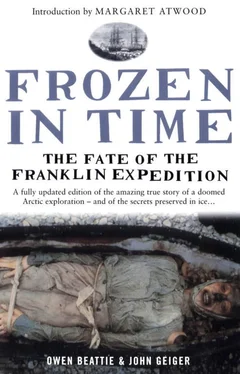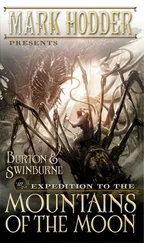In March, Gilpin wrote that “two men are now lying seriously ill in their cots, one of them afflicted with scurvy, the first case of that malignant disease, so much dreaded in these voyages.” A short time later, Gilpin recorded the death of a seaman on the Enterprise, noting that “for some time previous to his illness, he had been very melancholy, and from the time he was placed on the sick list never once rallied.” The seaman, a Jamaican named James Gray, had been one of the most cheerful men on the ship for the first months of the expedition, but by December 1848 he had become “gloomy, distant and solitary.” On 27 December he sought medical attention and was diagnosed as “suffering from Nostalgia.” John Robertson, surgeon on the Enterprise, described the curious affliction:
The symptoms which appeared most prominent in this unusual malady amongst British seamen was depression of spirits, a fearful foreboding of the future, an extraordinary anxiety for the welfare of his friends in England and an eternal craving to return home… [He] could not sleep for thinking of home and what a fool he was to come to a dark world like this, at Port Leopold.
Gray was placed on a diet of tinned meat and tinned vegetables, yet he continued to deteriorate, developing symptoms such as pains in the chest, exhaustion and incoherency. Bronchitis then intervened “on the pre-existing constitutional debility,” and he died on 16 April 1849. Robertson was impressed by Gray’s inconsolable longing to return to Jamaica: “This being the only mulatto we had on board, it would seem that children of the torrid zone have a greater love of home than ‘the children of the night’ of whom we had many.”
A second death followed on the Enterprise, on 30 April. The man, an able-bodied seaman named David Jenkins, had slipped while securing the ship to an iceberg nine months earlier. While no symptoms of the blow were visible for a lengthy period of time after the incident, his demise was attributed to a tumour that later developed. He suffered a “most lingering and painful illness.” Because of the unusual symptoms, an autopsy was conducted.
Then on 12 May, William Cundy, captain of the hold of the Investigator, died. Wrote Gilpin: “He was a weak, ill-made man, and his recovery despaired of soon after he was taken into the sick bay, his first illness was scurvy, but many unseen causes hastened his death.”
On 15 May, Sir James Clark Ross led the first of the sledging parties out in the search for Franklin. Ross marched west along the north coast of Somerset Island, then turned south, charting the island’s west coast and travelling in the general direction of the North Magnetic Pole and King William Land, which he had first visited nearly two decades earlier. Just over two weeks out, however, Ross was confronted with the near-total breakdown in the health of one of his party. Lieutenant Francis Leopold M’Clintock, who was also accompanying Ross, described the man’s condition: “James Bonnett now complained of spasmodic pains, loss of strength, giddiness, & c. He continued ailing, and unable to labour, for the remainder of the journey.” Three days later, M’Clintock recorded that the problem had spread to others: “Bonnett continues full of pains and devoid of strength, and all the other men are greatly reduced in strength; although our sledge gets lighter, they seem to be less able to drag it.”
The work was onerous, at times desperate, as the crew struggled southward over the hummocks and heavy crushed ice that served to fringe the “impregnable and forbidding” western coastline of Somerset Island. They travelled 250 miles (400 km) before Ross finally called an end to the search. At this point, a large cairn was constructed on a headland and a note deposited in a copper cylinder:
The cylinder which contains this paper was left here by a party detached from Her Majesty’s ships Enterprise and Investigator under the command of Captain Sir James C. Ross, Royal Navy in search of the expedition of Sir John Franklin; and to inform any of his party that might find it that these ships, having wintered at Port Leopold in long. 90°W, lat 73° 52’N have formed there a depot with provisions for the use of Sir John Franklin’s party sufficient for six months; also two very small depots about fifteen miles south of Cape Clarence and twelve miles south of Cape Seppings. The party are now about to return to the ships, which, as early as possible in the spring, will push forward to Melville Strait, and search the north coast of Barrow Strait; and, failing to meet the party they are seeking, will touch at Port Leopold on their way back, and then return to England before the winter shall set in.
7th June 1849. James C. Ross. Captain.
Ross’s party then began the return journey. He had sought to relieve Franklin, but concern for the health of his own men seriously hindered the efficacy of his search. Despite carrying with them lime juice as an antiscorbutic and the provision of a preferred diet of preserved beef and pea soup, several of his party were now “useless from lameness and debility,” so ill in fact that they had to be hauled on the sledges by the remaining men. M’Clintock recorded that five of the twelve men had “quite broken down.” Upon reaching Port Leopold thirty-nine days after setting out, Ross described his party as “so completely worn out by fatigue that every man was, from some cause or other, in the doctor’s hands for two or three weeks, and I am sorry to say that two of them are not yet recovered.” Gilpin remarked upon the “haggard looks and the attenuated forms of all of them.”
Unknowingly, at the furthest point of this sledge trek, Ross’s party came within 200 miles (320 km) of where Franklin’s ships had been deserted the previous summer. Ross had travelled south along Peel Sound, the very route that Franklin had taken in 1846. Later, M’Clintock lamented this failure, “because we were marching in the right direction, as [subsequent] discoveries… have proved.”
Other sledging parties were also dispatched from the two ships, though as Ross later discovered, “The labours of these parties were of comparatively short durations; still they, like ourselves, all suffered from snow blindness, sprained ankles, and debility.” One of the search parties travelled down the west shore of Prince Regent Inlet to Fury Beach, but the rigours of the journey also resulted in breakdowns in the health of some in the party. They did locate Somerset House, the structure occupied by the men under old Sir John Ross in 1832–33, and found it still standing. A tent was erected inside, fires were lit for warmth and two men—who were “too much fatigued to go any further”—were left as temporary occupants. The remainder of the party travelled only 25 miles (40 km) farther before erecting a cairn and returning to collect the invalids. The stores of the Fury were then examined and the contents tested. The tinned soup was declared “as good as when manufactured… most delicious, and in flavour and consistency, superior to any of our preserves of the same kind.”
Sailors’ dinner at Cape Seppings, Somerset Island, during James Clark Ross’s voyage of 1848–49 in search of Franklin.
By Lieutenant William Browne
While the physical demands of these sledge searches doubtless contributed to the outbreak of illness, those left aboard also fell sick. On 15 June 1849, Henry Mathias, assistant surgeon on the Enterprise, died. The death was blamed on consumption, which, “imperceptibly gaining on his strength, brought him to the grave.” John Robertson wrote that Mathias was “greatly beloved and respected by all in the expedition,” but that there was no hope of “getting him alive out of Port Leopold the grave of so many.” Ross observed: “Several others of the crews of both ships were in a declining state, and the general report of health was by no means cheering.” Even the Enterprises surgeon fell seriously ill. Robertson wrote that he suffered from scurvy and only “narrowly escaped destruction,” though he would continue to suffer active symptoms of “this abominable scourge” seven months later, even after his return to England.
Читать дальше










